Struggling with a room that feels more like a gloomy cave than a welcoming sanctuary? You're not alone. The fix, however, is often simpler than you might think. It’s all about working smarter, not harder, with the light you’ve got.
The secret lies in a three-pronged approach: maximising natural light, layering your artificial lighting, and using clever tricks with reflective surfaces. Sometimes, a single change, like placing a large mirror opposite a window or ditching heavy drapes for something more delicate, can make an incredible difference straight away.
Your Instant Plan for a Brighter Room
Before you start agonising over paint swatches or planning a major furniture reshuffle, let's look at some quick wins. These are the small, strategic moves that deliver big results, often in a single afternoon. The aim is to enhance every bit of daylight and then thoughtfully add more where it's needed most.
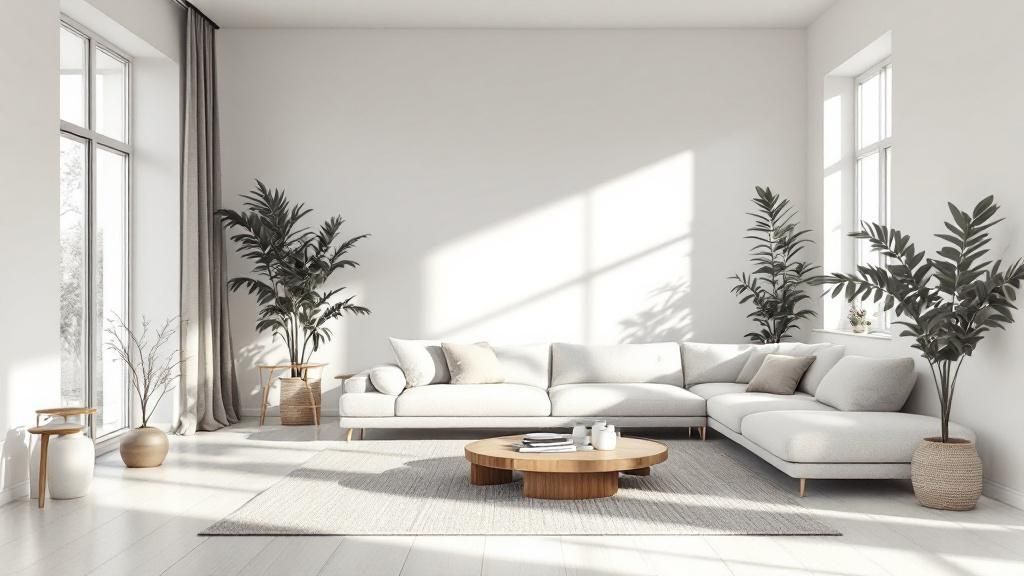
Think of this as your action plan for creating a space that feels instantly brighter and more open.
Start with the Obvious: Your Lighting
First things first, take a hard look at your current lighting. Is a single, lonely ceiling light trying to do all the heavy lifting? That’s a common mistake that almost always results in harsh shadows and a flat, uninviting atmosphere.
The solution is to layer your lighting. This just means using a mix of different light sources to build a balanced, functional, and cosy environment.
Here are a few things you can do right now:
- Master the Mirror Trick: Find your room's biggest window and hang a large mirror on the opposite wall. It’s the oldest trick in the book for a reason – it literally bounces daylight back into the space, effectively doubling the brightness.
- Light Up the Corners: Dark corners make a room feel smaller. Pop a floor lamp in a shadowy spot or add a table lamp to a side table. This draws your eye around the room and creates pockets of warm, inviting light.
- Rethink Your Windows: Those heavy, dark curtains might be cosy in winter, but they’re also light-absorbing black holes. Swapping them for lightweight, sheer fabrics or simple blinds will let daylight flood in while still giving you a bit of privacy.
The key is to work with the light, not against it. Clear the way for natural sunlight and then fill in the gaps with well-placed lamps. You can completely change the mood of a room without touching a paintbrush.
For a quick overview, here are some of the most effective changes you can make, broken down by how much effort they take.
Quick Wins for a Brighter Room
Even tackling just one or two of these ideas can make a noticeable improvement, helping you reclaim your space from the shadows.
Choosing Paint to Maximise Natural Light
Everyone says to just paint a dark room white, but the real magic is in the details. It's less about the specific colour you choose and more about how that paint plays with the light you do have. Getting a handle on a few technical bits can completely transform a space from dull to dazzling.
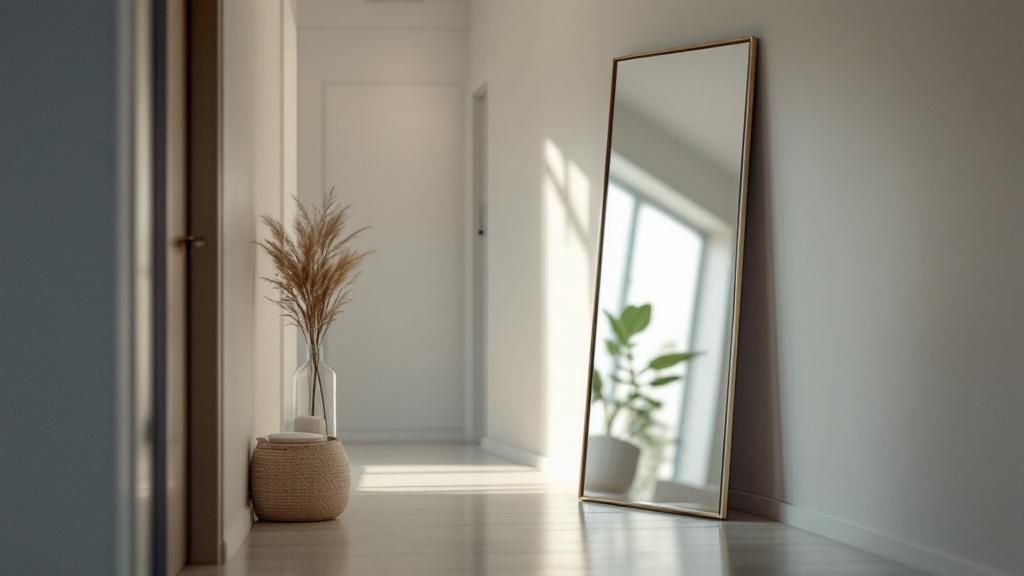
The first thing to get your head around is a paint's Light Reflectance Value, or LRV. Every single paint colour has a score from 0 (think absolute black) to 100 (pure white), which tells you exactly how much light it reflects back into the room.
For a space that feels a bit dim, you'll want to look for paints with an LRV of 60 or higher. This ensures you’re bouncing as much precious light around as possible. But a high LRV is only half the battle.
Understanding Undertones and Finishes
A paint's undertone is its subtle, underlying hue, and it completely sets the mood. In a small, north-facing room, a pale grey with cool blue undertones can work wonders, creating an airy, expansive feeling. On the other hand, a creamy off-white with warm yellow undertones can bring in a sense of sunshine, even on the greyest of days.
The finish you pick is just as important. Matte paint has a lovely modern, flat look, but the problem is it tends to absorb light.
In a dark room, an eggshell or satin finish is almost always a better bet. These have a soft sheen that gently catches and reflects light, creating a subtle glow that you just don't get from a flat matte. It instantly makes the space feel brighter and more alive.
This doesn't mean you're stuck with white or cream, though. Exploring different paint colour ideas for a living room can open your eyes to stunning pale shades that do the job beautifully.
My best advice? Always, always test samples on your own walls. See how they look in the morning, afternoon, and evening light before you even think about buying a full tin. It makes all the difference.
Layering Light for All-Day Brightness
One of the most common mistakes is relying on a single, lonely ceiling light to do all the heavy lifting. It’s a sure-fire way to end up with a room that feels flat, one-dimensional, and full of gloomy corners.
To really banish the shadows for good, you need to think like a designer and start layering your light. It’s all about mixing and matching different light sources to create an atmosphere that feels balanced, inviting, and works beautifully from morning to night.
The idea is pretty straightforward once you get the hang of it: use three different types of light to build depth and make sure every part of the room feels considered. Each layer has its own job to do, and together, they create a space that’s both functional and full of character.
The Three Essential Lighting Layers
A beautifully lit room doesn't happen by accident. It starts with a simple plan that brings these key players into the mix. By placing different fixtures strategically, you can completely control the mood and function of your space.
- Ambient Lighting: Think of this as your foundation. It’s the general, all-over light that lets you see where you’re going. This usually comes from a central ceiling fixture, a series of downlights, or even track lighting.
- Task Lighting: Just like it sounds, this is your focused light for getting things done. It’s the lamp on your desk for late-night work, the lights under your kitchen cabinets for chopping veg, or the floor lamp you pull up next to your armchair for reading.
- Accent Lighting: Now for the fun part! This is the decorative layer that adds a bit of drama. Accent lights are all about highlighting the things you love, whether it's a piece of art, a cool architectural feature, or a collection of houseplants. Picture wall sconces washing a wall in a soft glow or a tiny spotlight aimed at a beautiful vase.
Layering isn’t just about cramming more lamps into a room; it’s about creating a dynamic, living space. A slim floor lamp tucked into a forgotten corner can make the whole room feel bigger. Task lighting makes a reading nook practical without having to blast the entire room with harsh overhead light.
Choosing the Right Bulbs
The light bulb you choose is just as important as the lamp you put it in. Seriously. Modern LED bulbs have completely changed the game, offering incredible energy efficiency and, more importantly, total control over the quality of the light.
When you're picking out bulbs, keep an eye on two key numbers:
- Lumens (Brightness): This is simply how much light the bulb puts out. Higher lumens equals a brighter light. Simple as that.
- Kelvins (Colour Temperature): This tells you about the colour of the light, from a warm, cosy yellow to a cool, crisp blue. For a welcoming feel that mimics natural daylight and keeps a space feeling bright, always stick to bulbs in the 2700K to 3000K range.
It’s clear that we’re all waking up to the power of good lighting. The UK LED lighting market is now valued at around USD 2.9 billion, as more of us are upgrading our homes for better brightness and efficiency. In fact, these improvements have inspired over 39% of UK consumers to buy new lighting products recently. If you’re ready to join them, you might want to check out our guide on lighting ideas for your home for some extra inspiration.
Using Mirrors and Reflective Decor Smartly
Once you’ve got your paint and lighting sorted, it’s time for an interior designer’s oldest trick in the book: mirrors. Seriously, don't underestimate them. Think of a mirror less as something to check your hair in and more as a secret window, capable of bouncing light into the gloomiest of corners.
But where you put it is absolutely key.
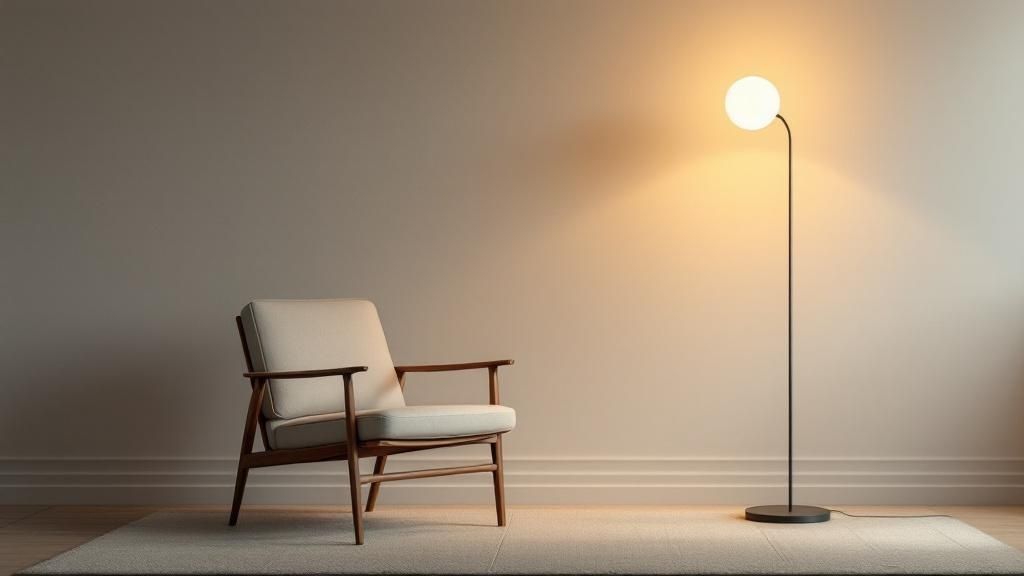
The single most effective thing you can do is hang a large mirror directly opposite your main window. This one simple move can practically double the amount of natural light in the room, making it feel instantly bigger and more alive. It’s a game-changer.
Creative Ways to Use Reflection
While one statement mirror is a fantastic start, you don't have to stop there. A gallery wall of smaller, mismatched mirrors can look incredible, scattering light in all directions and adding a bit of quirky personality to the space.
And it’s not just about mirrors. Think about other reflective surfaces you can bring in:
- Metallic Finishes: A touch of gold, silver, or brass goes a long way. Look for picture frames, the base of a lamp, or even the legs on a console table. These little details catch the eye and create a subtle shimmer.
- Glass Surfaces: If you’ve got a heavy, dark wooden coffee table, consider swapping it for a glass one. Light will travel right through it, making the whole area feel less cluttered and much more open.
- High-Gloss Furniture: A sleek sideboard or a set of cabinets with a high-gloss finish can act like a subtle mirror, softly reflecting light from your lamps and windows. It adds a lovely ambient glow without being too in-your-face.
The real aim is to create multiple points of reflection. Every shiny surface becomes a tiny lighthouse, pushing back the shadows and helping your space feel brighter and more expansive.
By layering in these reflective elements, you're encouraging light to dance around the room. It’s a simple but brilliant way to create a home that feels bright, airy, and thoughtfully put together.
Arranging Furniture to Create Openness
How you place your furniture can make or break a room's brightness. Get it right, and light flows freely; get it wrong, and you create gloomy corners. When tackling a dark room, think of your layout as a series of pathways for light to travel from the window inwards.
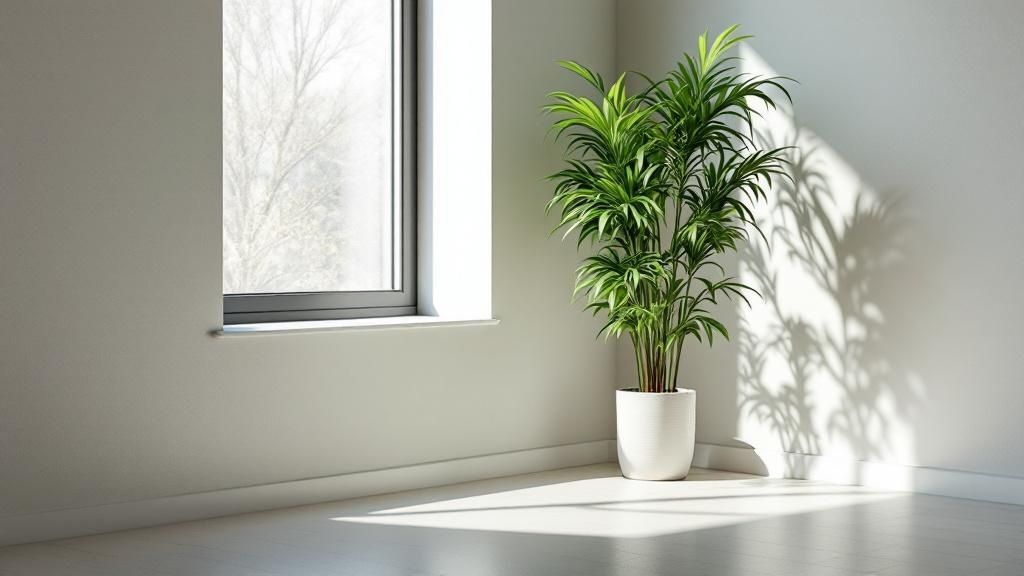
Often, the main offender is heavy, bulky furniture that sits flat on the floor. These solid pieces act like visual roadblocks, casting deep, stagnant shadows and instantly making a space feel smaller and darker. The fix, thankfully, is quite simple.
Choose Furniture That Breathes
Look for what we in the design world call ‘leggy’ furniture—pieces that are raised up on slender, visible legs. Think sofas, armchairs, and coffee tables where you can see the floor underneath. It’s amazing how this small detail creates an instant illusion of more space, allowing light to move freely and banishing those dark shadows.
Light-coloured upholstery also works wonders. A sofa in a soft beige, cream, or pale grey will reflect far more light than a dark, heavy one. If you’re worried about spills, don’t be. Modern performance fabrics are brilliant and offer fantastic stain resistance without sacrificing style.
One of the most common mistakes is furniture pushed flush against the walls. Pulling your sofa even a few inches away creates a little breathing room. This simple trick stops shadows from pooling and makes the layout feel much more considered and airy.
Create Clear Light Paths
It might sound obvious, but your layout should never block your main light source. I’ve seen so many homes where a tall bookcase or a chunky armchair is placed right in front of a window, cutting off precious daylight.
Instead, arrange your main seating area to feel open and inviting, ensuring a clear, unobstructed path for light to flood in.
It’s a strategy that’s becoming more important than ever. As we all look for ways to make our homes brighter, the demand for effective lighting is soaring. In fact, UK imports of lighting products are predicted to climb from around $862 million to nearly $956 million in just the next few years.
Dealing with a compact room? A clever layout is non-negotiable. If you're feeling a bit stuck, our guide on small living room layout ideas has plenty more tips to help you make the most of every inch.
Smart Window Treatments That Let Light In
If there's one thing that can single-handedly sabotage a bright room, it's heavy, dark curtains. Getting your window dressings right is all about inviting the light in, not shutting it out. Swapping bulky drapes for something lighter is one of the simplest yet most effective changes you can make.
Think about beautiful, breezy fabrics like sheer linen or voiles. These materials give you a lovely bit of privacy but still allow soft, diffused daylight to flood the room, making it feel instantly more airy and spacious. They filter the light instead of blocking it, creating a gentle, welcoming glow.
Maximise Your Window Frame
Here’s a trick straight from the interior designer’s handbook: to make any window feel bigger and let in more sun, it’s all about where you hang the curtain rod. Mount the rod at least four to six inches above the window frame, and make sure it extends three to six inches wider on each side.
This simple shift tricks the eye into perceiving a larger window. When you pull the curtains back, they’ll frame the view beautifully instead of covering the edges of the glass, letting in every last bit of available light.
For more practical tips, our complete curtain buying guide is packed with helpful advice.
Of course, it’s not just about curtains. There are other brilliant alternatives.
- Light-filtering cellular shades: These are fantastic for insulation and cast a soft, uniform light across the room.
- Classic Venetian blinds: You can't beat them for precise control. Just angle the slats to direct sunlight exactly where you need it throughout the day.
This focus on making the most of natural light is part of a much bigger picture. As we all become more energy-conscious, better lighting solutions are key. It’s no surprise that complete LED fixtures, known as luminaires, make up a huge 59.54% of the LED market revenue this year in the UK. We see them used all the time in homes to add both brightness and style. You can read more about UK LED lighting trends on grandviewresearch.com.
A Few Lingering Questions
Still wrestling with a few details? Let's clear up some of the most common questions that pop up when trying to brighten a dark room.
What’s the Best Paint Colour for a Dark Room?
There's no single magic bullet, but a high-quality white with a high Light Reflectance Value (LRV) is always a safe bet. Whites with warmer undertones can keep the space from feeling too clinical or stark.
If you want a hint of colour, a very pale grey or a soft, light blue can be fantastic. These shades have a breezy, airy quality that makes a room feel instantly larger and more open.
Will Adding More Lamps Send My Electricity Bill Through the Roof?
Not if you're smart about your choices! Modern LED bulbs are a game-changer, using up to 80% less energy than the old incandescent bulbs we all grew up with.
By making the switch to LEDs and layering your lighting, you'll only use the lights you actually need at any given moment. This approach lets you brighten your space dramatically without a nasty surprise on your next energy bill.
The trick is to create balanced, purposeful lighting, not just flood the room with more lights. A thoughtful mix of ambient, task, and accent lighting makes a space bright and functional without wasting a drop of energy.
Are Dark Floors a No-Go in a Room I Want to Feel Brighter?
Not at all! In fact, they can be a brilliant design choice. Dark floors can ground a room and, through contrast, actually make light-coloured walls seem even brighter and taller.
The key is balance. Pair your dark floors with light-coloured walls and a large, pale area rug to lift the space.
Adding a bit of greenery is another great way to bring life into the room without casting shadows. If you're not sure where to start, our guide to the best plants for dark rooms has some fantastic low-light options.

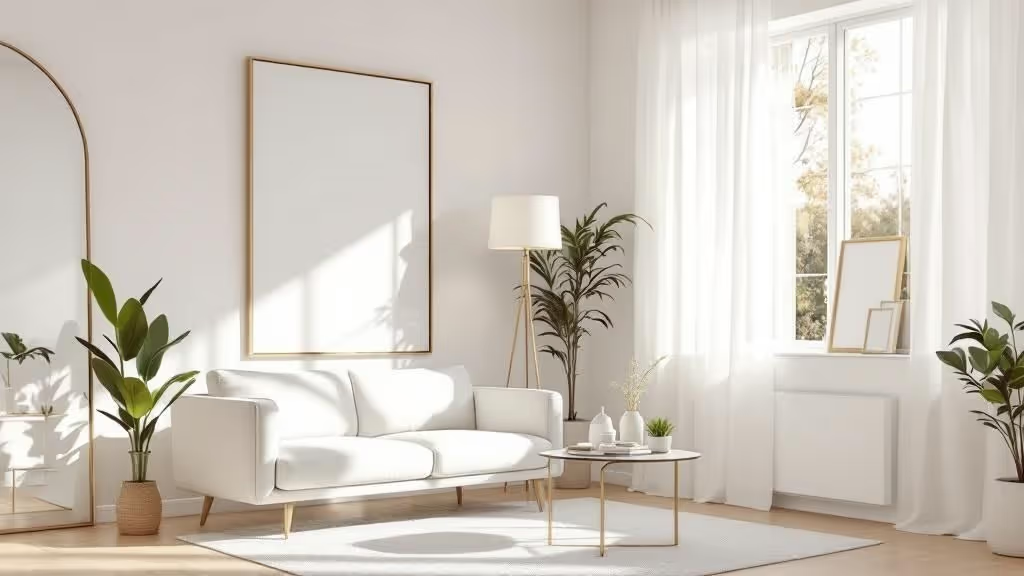
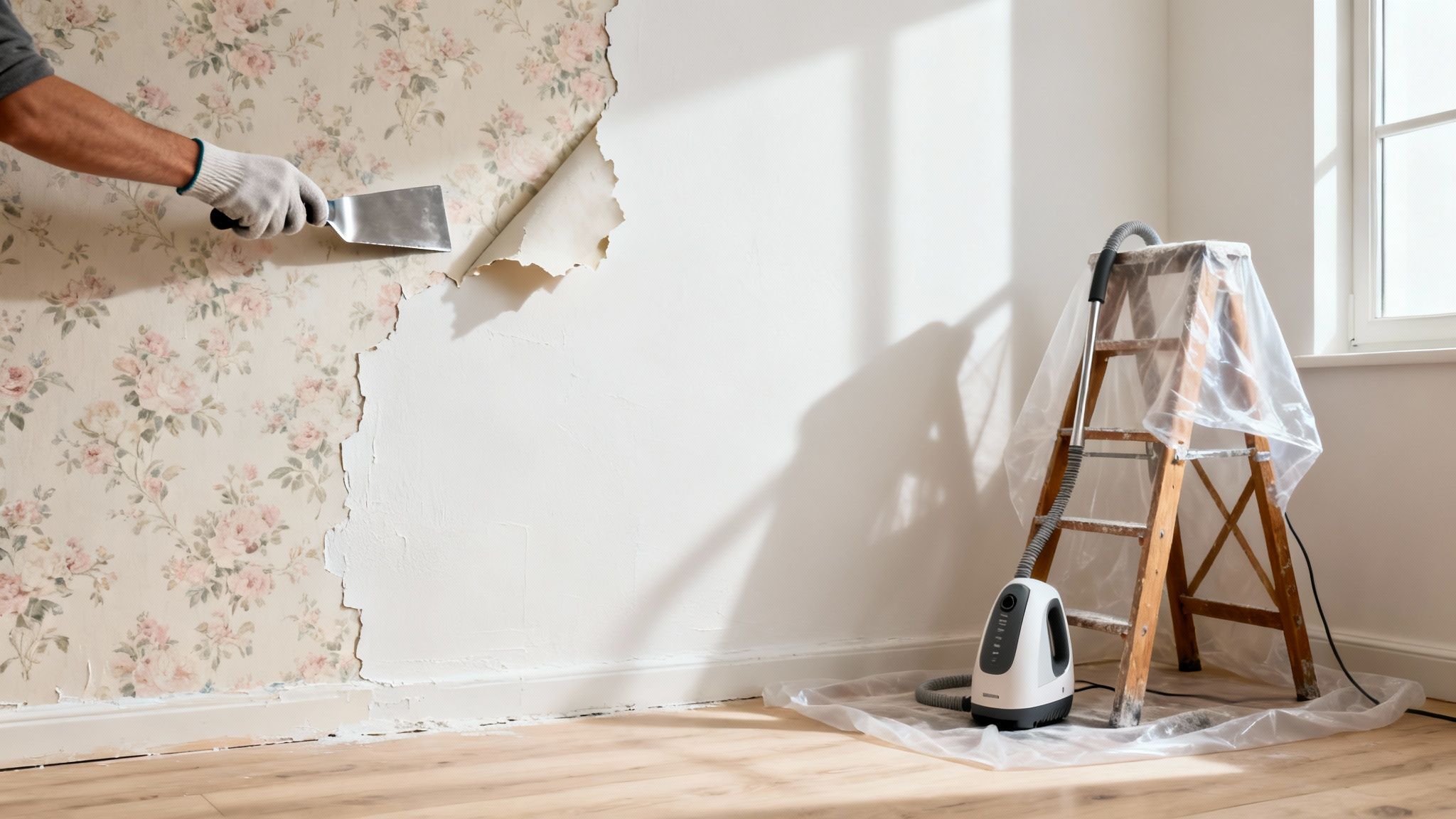
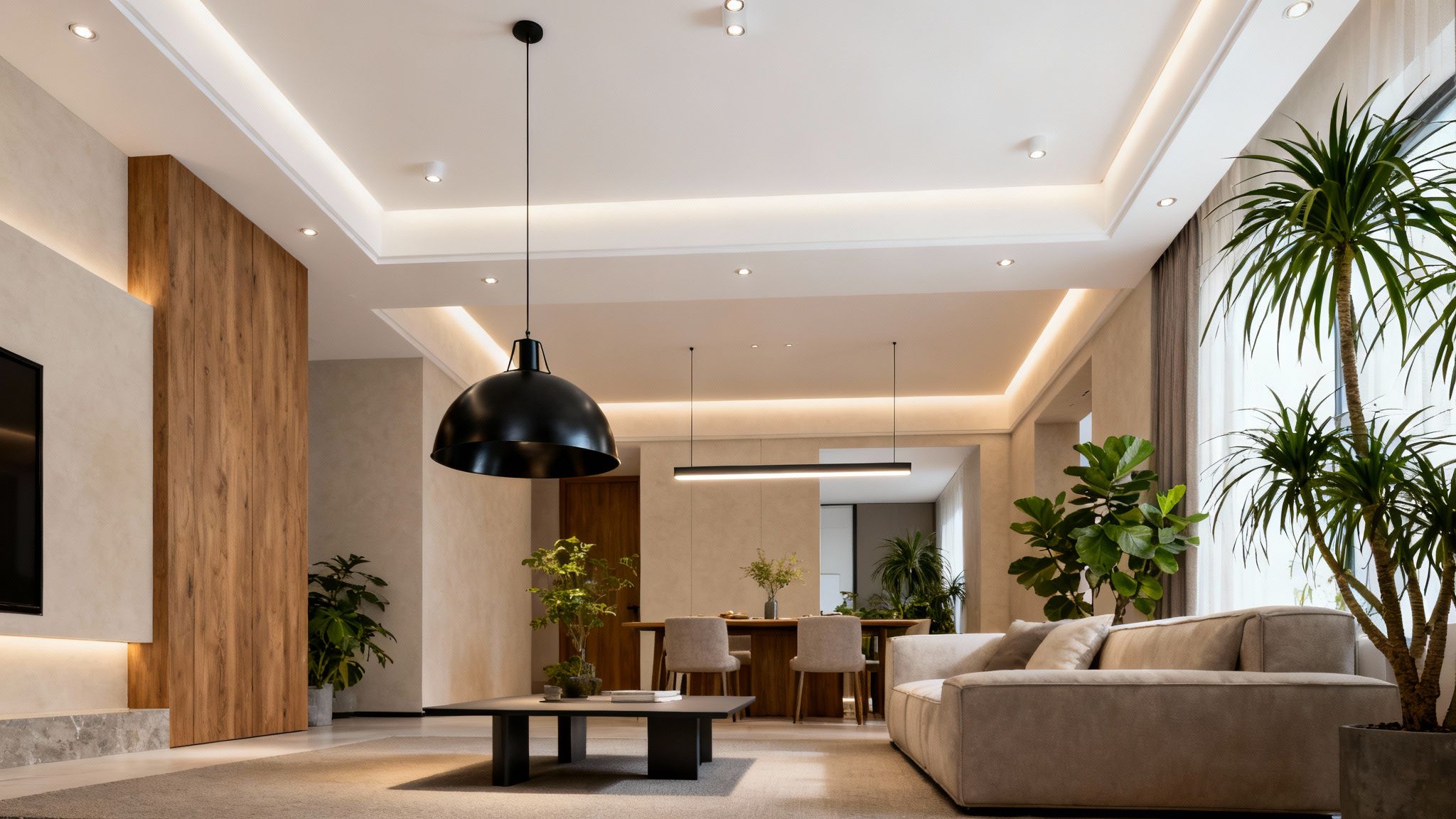
.jpeg)